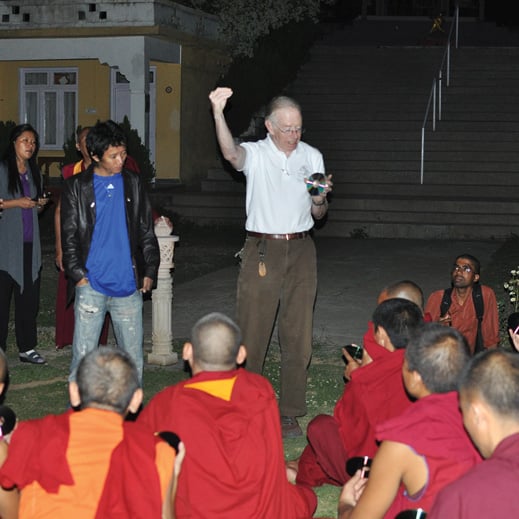After nearly four decades in teaching, Paul Doherty has encountered all types of students. As a professor at Oakland University, he taught physics, astronomy, geology, meteorology, and computer programming for 12 years. And as co-director of San Francisco’s Exploratorium Teacher Institute, where he has worked since 1986, he instructs middle-school and high-school teachers in the institute’s inquiry-based, hands-on learning techniques.

“I love teaching—it’s the best job anyone could imagine,” he says. “I’m working with teachers all over the world. The Exploratorium is the craziest group of smart, creative people you’ve ever seen.”
One highlight of his career was an appearance on the Late Show with David Letterman, where he and Letterman demonstrated the opposite effects that helium and sulfur hexafluoride can have on the human voice.
Another is a new venture teaching his favorite group to date: Buddhist monks and nuns. In 2011, through the Exploratorium, Doherty became involved in Science for Monks, a nonprofit that teaches in exiled Tibetan monastic communities.
“They’re the best students I’ve had in 40 years,” he says. “They come from a culture and belief system that is so moving. When the Buddhist way of thinking differed with the science that was presented, a great deal of mutual respect carried us through the lessons.”
One example of the differences: while science tells us that the ink inside a red pen is red regardless of whether you can see it from the outside, a Buddhist might ask, “If no one can see the ink inside a red pen, is it still red? How do you know it’s still red if it is not seen?”
Since joining Science for Monks, Doherty has made frequent visits to the College for Higher Tibetan Studies near Dharamsala, India, where he teaches 60 monks and nuns modern high-school-level science.
“It’s such a powerful way to learn physics,” he says. “The richness of their questions and arguments was a really great thing to see.”
Doherty is learning, too, as he works with this ancient system of practices and beliefs that aim to end human suffering. “Buddhism steps outside the boundaries of experimental science,” he says. “And not every question can be answered by a scientific experiment. There is a strong need for other philosophies.”
Originally from Boston, Doherty lives in Mountain View, California, with his wife of 38 years, Ellen, whom he met when she was working in an MIT physics lab. He enjoys playing the whirly, an instrument made from a corrugated plastic tube, and is an avid rock climber who has twice climbed 26 miles—a “vertical marathon.”
Keep Reading
Most Popular
Large language models can do jaw-dropping things. But nobody knows exactly why.
And that's a problem. Figuring it out is one of the biggest scientific puzzles of our time and a crucial step towards controlling more powerful future models.
How scientists traced a mysterious covid case back to six toilets
When wastewater surveillance turns into a hunt for a single infected individual, the ethics get tricky.
The problem with plug-in hybrids? Their drivers.
Plug-in hybrids are often sold as a transition to EVs, but new data from Europe shows we’re still underestimating the emissions they produce.
Google DeepMind’s new generative model makes Super Mario–like games from scratch
Genie learns how to control games by watching hours and hours of video. It could help train next-gen robots too.
Stay connected
Get the latest updates from
MIT Technology Review
Discover special offers, top stories, upcoming events, and more.